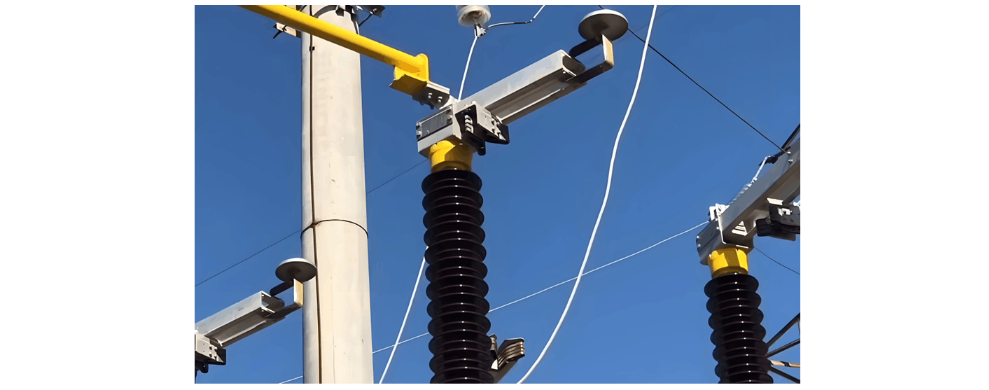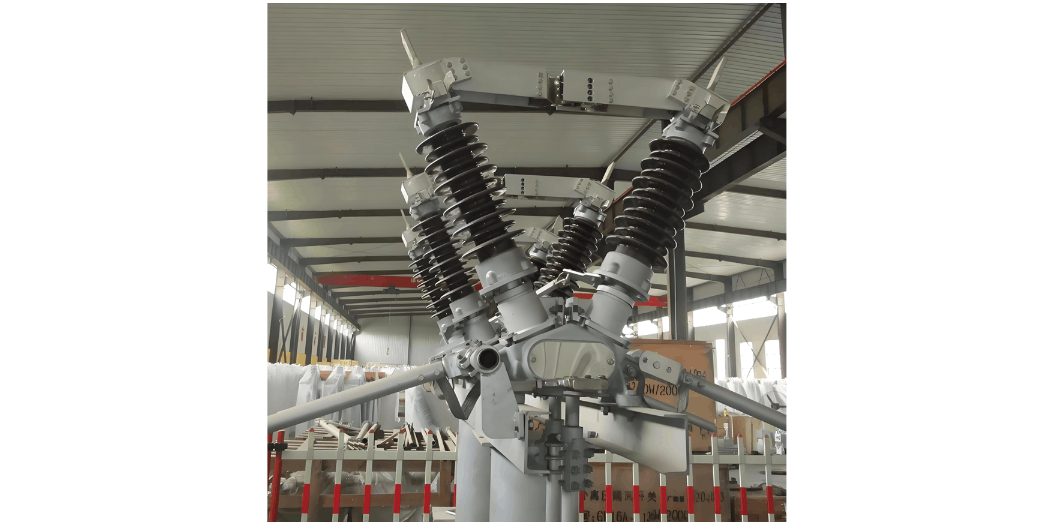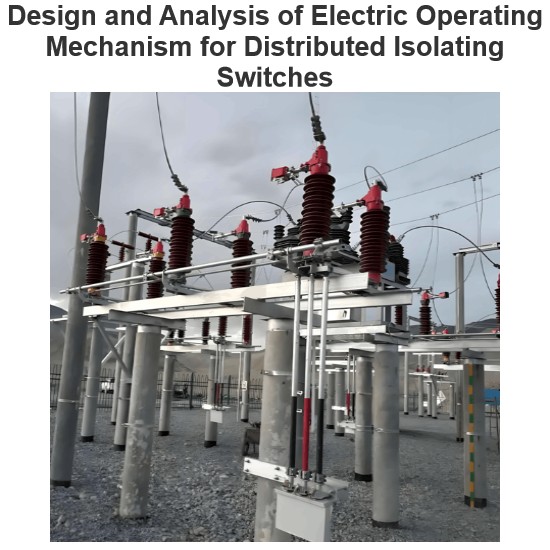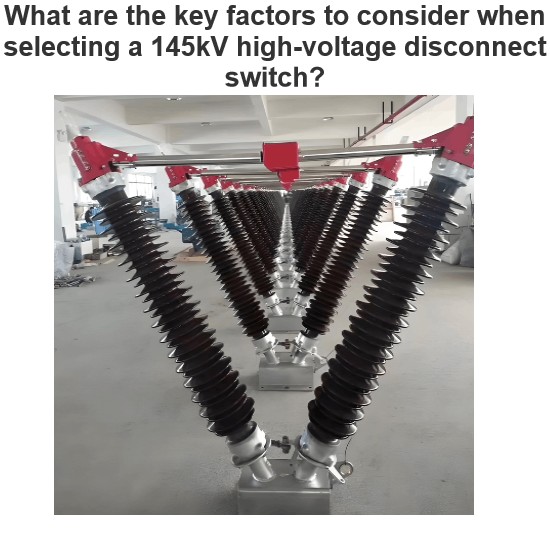High-voltage disconnect switches are widely used in thermal power plants and are one of the important devices to ensure the stable operation of the power system in thermal power plants. They are mainly composed of moving and static contact components, switch bases, transmission mechanisms, operating mechanisms, porcelain insulators and porcelain insulator bases. During the maintenance of electrical equipment, high-voltage disconnect switches can disconnect the electrical equipment from the power grid to ensure the safety of maintenance personnel and equipment. In addition, disconnect switches can realize the mutual switching of busbars in double busbar wiring to meet the operating requirements of working conditions.
In actual operation, due to the complex operating environment of thermal power plants and the influence of factors such as improper operation and maintenance by staff, high-voltage disconnect switches will have faults such as overheating and incomplete opening and closing, which will affect the normal operation of the power generation system of thermal power plants. Therefore, summarizing the common faults and troubleshooting countermeasures of high-voltage disconnect switches is of great significance to ensure the normal operation of the power generation system of thermal power plants.
Research Background on Faults and Causes of High-voltage Disconnect Switches
Overheating of Disconnect Switches
Overheating is one of the common faults of disconnect switches. The main reasons for the overheating of disconnect switches include component corrosion, aging, switch overload or loose contact surfaces, contact oxidation, loose compression springs, etc. The commonly used material for disconnect switches is galvanized steel pin shaft, which will be rusted when exposed to the complex environment of the power plant for a long time, resulting in poor contact between the moving and static contacts. The moving and static contacts are easily corroded by water vapor and chemical gases in the air for a long time, forming an oxide film, which increases the contact resistance. The compression springs of the disconnect switch contacts will also age and loosen due to long-term operation, and the compression force is insufficient, resulting in poor contact, increased contact resistance, and overheating of the disconnect switch.
Incomplete Opening and Closing
The main reasons for the incomplete opening and closing of the disconnect switch are the deterioration of the lubricating oil in the rotating part of the disconnect switch, loose bolts, deformation of the auxiliary switch transmission rod, and the decrease of the mechanism stroke caused by the corrosion of the internal components of the mechanism box, etc. In the complex environment of thermal power plants, high temperature, weathering, etc. will cause the lubricant in the rotating parts of the disconnect switch to deteriorate, and the dust falling into the lubricant will easily hinder the movement of the disconnect switch mechanism, resulting in incomplete opening and closing of the switch or great resistance to opening and closing.
In the actual operation process, due to the changes in temperature and load, the long-term thermal expansion and contraction will cause the bolts to loosen. The deformation of the auxiliary switch transmission rod will lead to unstable state reversal, so that the disconnect switch will cut off the power before reaching the opening and closing position, resulting in incomplete opening and closing of the disconnect switch. In addition, improper adjustment of the opening and closing positioning device, improper adjustment of the limit switch, and poor meshing of the drive motor gear, loose or serious wear of the gear, etc. will also lead to incomplete opening and closing of the disconnect switch.
Refusal to Open and Close
The incomplete opening of the grounding knife will make the mechanical lock lock the closing action of the disconnect switch, resulting in the inability to close the disconnect switch. In rainy and humid environments, the bearings in the mechanism box will be rusted, which will increase the resistance to opening and closing. If the rusting is aggravated, the resistance will be further increased, resulting in the disconnect switch refusing to open and close. In addition, the deformation of the mechanical lock or the improper installation position after maintenance will also lead to the refusal of the disconnect switch to open and close.
Three-phase Asynchronism during Opening and Closing
The main reason is that the balance spring of the knife switch in the conductive tube of the disconnect switch is rusted or the stress is insufficient, which will increase the action resistance of the knife switch and lead to three-phase asynchronism. In actual operation, if the matching clearance of a certain part of a certain phase is large, the gear meshing is poor, etc., three-phase asynchronism may occur.
Fracture of Porcelain Insulator
The reasons for the fracture of the porcelain insulator are its own quality defects, long-term aging, corrosion, and inadequate maintenance, etc. Some porcelain insulators have quality defects in the production process, and the acceptance work after installation is not detailed, resulting in easy fracture of the porcelain insulator. In addition, in the usual maintenance process, the staff's maintenance is not in place, and the oil pollution on the surface of the porcelain insulator leads to the failure to timely find the slight cracks of the porcelain insulator. In addition, the aging of the porcelain insulator and surface corrosion may lead to the reduction of the strength of the porcelain insulator, and if it is not replaced in time, it will fracture. In addition, the improper installation of switch components leads to uneven force on the porcelain insulator, which is prone to cracks.
Countermeasures for High-Voltage Disconnect Switch Faults
Overheating Treatment
In practical operation, select disconnect switches with good thermal stability, synchronized opening/closing, high mechanical and insulation strength. Ensure disconnection points are visible to confirm isolation from the grid, with insulation distance meeting operational requirements, and interlocking mechanisms for switches with grounding knives. For overheating faults, check contacts for oxidation—lightly sand minor oxidation, clean with alcohol, and apply vaseline after drying. For corroded surfaces, smooth defects and adjust contacts for proper embedding. Wipe oily contacts with gasoline, replace defective compression springs and contacts. Adjust misaligned moving contacts or insufficient insertion depth, and tighten loose bolts with a torque wrench to specified values.
Incomplete Switching Treatment
Regularly replace lubricants in the mechanism, disassembling components for thorough cleaning before adding new lubricant. Inspect transmission rods for deformation, straighten and reinstall deformed ones. Check positioning devices for opening/closing positions—rectify and reset deformed ones, or remove and refix after ensuring full switching if intact. For increased resistance from corrosion in the mechanism box, open the box, clean components, reapplying lubricant and replacing severely rusted parts. Remove rust from return springs, apply anti-rust treatment, and replace aged springs. Rectify deformed or loose interlocking components, and tighten loose parts. Check drive motor gears/worms for looseness or wear, tightening or replacing as needed.
Switching Refusal Treatment
When the switch refuses to open/close, if the contactor doesn’t act, check power supply and fuses. If the contactor acts, verify outlet voltage—if normal, inspect contacts; if abnormal, trace issues to the drive motor or cables. Check mechanical interlocks, mechanism box, and transmission system for rust, looseness, or detachment; ensure grounding knives are fully open. For jams due to poor lubrication, add/replace lubricant and operate repeatedly. Polish or replace rusted operation mechanism parts. Rectify deformed mechanical interlocks or reinstall at the correct position.
Three-Phase Asynchrony Treatment
During electric operation, observe delayed phases. Sudden acceleration/stopping indicates excessive resistance—isolate power, locate and remove the resistance point. Uniform slow movement suggests gear meshing issues, requiring adjustment or replacement. Replace balance springs with insufficient stress.
Porcelain Insulator Fracture Prevention
Select certified porcelain insulators and standardize maintenance to avoid installation-induced fractures. Regularly wipe surfaces to remove dust and oil, inspect for glaze loss, cracks, base deformation, or rust; check connecting pins and washers. Test insulation resistance and use ultrasonic technology to detect internal defects, replacing cracked or severely flashover-damaged insulators.
Conclusion
High-voltage disconnect switches are vital for protecting power equipment and personnel in thermal power plants. Plants should establish strict maintenance protocols, defining overhaul cycles and tasks, and enforce standardized operation to eliminate hidden dangers. This enhances equipment reliability, reduces operational failures, and boosts economic efficiency by minimizing power generation interruptions.















